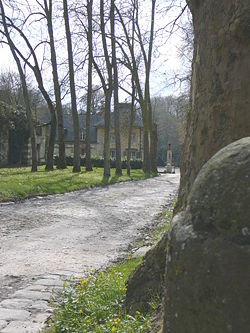
Château du Saussay
Encyclopedia

Château
A château is a manor house or residence of the lord of the manor or a country house of nobility or gentry, with or without fortifications, originally—and still most frequently—in French-speaking regions...
that forms part of the commune
Communes of France
The commune is the lowest level of administrative division in the French Republic. French communes are roughly equivalent to incorporated municipalities or villages in the United States or Gemeinden in Germany...
of Ballancourt-sur-Essonne
Ballancourt-sur-Essonne
Ballancourt-sur-Essonne is a commune in the Essonne department in Île-de-France in northern France.-Geography:The Essonne forms the commune western border.Inhabitants of Ballancourt-sur-Essonne are known as Ballancourtois.-References:**...
in the department of Essonne
Essonne
Essonne is a French department in the region of Île-de-France. It is named after the Essonne River.It was formed on 1 January 1968 when Seine-et-Oise was split into smaller departments.- History :...
. It is situated in the valley of the river Essonne between Corbeil
Corbeil-Essonnes
Corbeil-Essonnes is a commune in the southern suburbs of Paris, France. It is located from the center of Paris.Although neighboring Évry is the official seat of the Arrondissement of Évry, the sub-prefecture building and administration are located inside the commune of Corbeil-Essonnes.In the 19th...
and La Ferté-Alais
La Ferté-Alais
La Ferté-Alais is a commune in the Essonne department in Île-de-France in northern France. It is south of Paris.Its airfield , hosts a world-famous air show for vintage World War I and WWII aircraft and a museum of such aircraft....
, on the territory of an old Templar commandery. It is built on the ruins of a 15th century feudal castle, and is a rare collection of two 18th century châteaux facing each other at the entrance to a Romantic
Romanticism
Romanticism was an artistic, literary and intellectual movement that originated in the second half of the 18th century in Europe, and gained strength in reaction to the Industrial Revolution...
park surrounded by water. Inside, their reception rooms evoke the lives of their inhabitants.
History
The property of Olivier Le DaimOlivier le Daim
Olivier le Daim [or le Dain] , favourite of Louis XI of France, was born of humble parentage at Tielt in Flanders.Seeking his fortune at Paris, he became court barber and valet to Louis XI, and so ingratiated himself with the king that in 1474 he was ennobled under the title Le Daim and in 1477...
, barber to the French kings from Louis XI to Louis XV, the château was burned by the Spanish during the Wars of Religion
French Wars of Religion
The French Wars of Religion is the name given to a period of civil infighting and military operations, primarily fought between French Catholics and Protestants . The conflict involved the factional disputes between the aristocratic houses of France, such as the House of Bourbon and House of Guise...
.
The owner obtained permission from Henry IV
Henry IV of France
Henry IV , Henri-Quatre, was King of France from 1589 to 1610 and King of Navarre from 1572 to 1610. He was the first monarch of the Bourbon branch of the Capetian dynasty in France....
by letters patent to surround the château with water. He then rebuilt the château in the brick-and-stone style. The property of Me de Gaumont, a member of parliament, it was handed down by the women of the Bragelongne family, by Canclaux and finally Colbert
Auguste François-Marie de Colbert-Chabanais
Auguste François-Marie de Colbert-Chabanais, born 18 October 1777 in Paris - died 3 January 1809, Cacabelos, Spain), Comte de l'Empire joined the French army during the French Revolutionary Wars. He became a general officer of cavalry during the Napoleonic Wars and fought in a number of major...
at the start of the 19th century.
In 1735 a pavilion - identical in appearance to the original château - was built facing it, to give the appearance (surviving to this day) of two châteaux opening onto a park. Just before the French Revolution
French Revolution
The French Revolution , sometimes distinguished as the 'Great French Revolution' , was a period of radical social and political upheaval in France and Europe. The absolute monarchy that had ruled France for centuries collapsed in three years...
, the entry building and raised bridge were demolished and replaced with two elegant pavilions in the style of the architect Nicolas Ledoux (end of the 18th century). In the 19th century the Colberts doubled the size of the main pavilion and endowed the château with a magnificent library.
At the start of the 20th century, the château passed to the Bourbon Busset family, and the park was redesigned by the great landscape artist Achille Duchêne
Achille Duchêne
Achille Duchêne was a French garden designer who worked in the grand manner established by André Le Nôtre. The son of the landscaper...
, joining the charm of parks in the English style with classical harmony of gardens in the French style. His redesigned park was made up of three perspectives, several water features, and lawns framed with topiary or planted with rare trees. The académicien Jacques de Bourbon Busset
Jacques de Bourbon Busset
Jacques de Bourbon Busset, Count of Busset was a French novelist, essayist and politician. He was elected to the Académie française on June 4, 1981.-Bibliography:...
lived in this château, where his children, grandchildren and great-grandchildren still live today.

